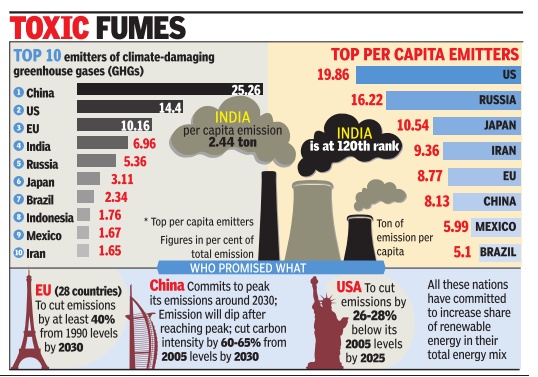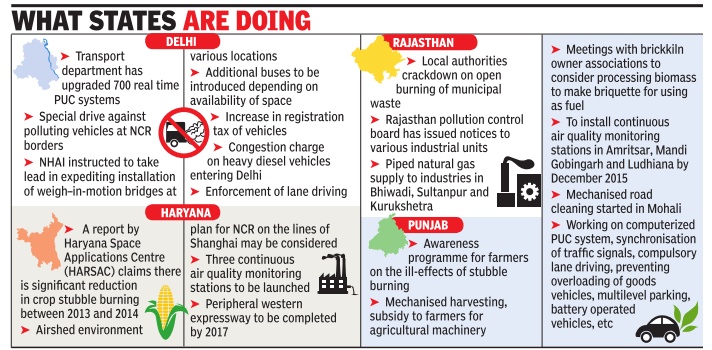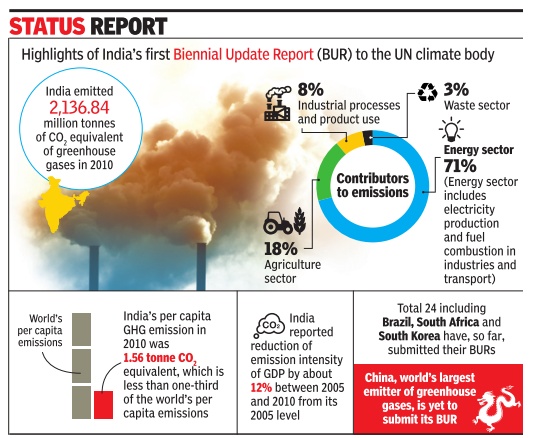Air pollution: India
| Line 46: | Line 46: | ||
Emissions from cooking with biomass also contribute a quarter of ambient PM2.5 levels in the country , the report notes. | Emissions from cooking with biomass also contribute a quarter of ambient PM2.5 levels in the country , the report notes. | ||
| + | |||
| + | =Carbon emission intensity= | ||
| + | ==2005-10: emissions reduced by 12%== | ||
| + | [[File: Total greenhouse gas emissions by India in 2010, as well as the sectors of the economy that contributed to these emissions.jpg| Total greenhouse gas emissions by India in 2010, as well as the sectors of the economy that contributed to these emissions; Graphic courtesy: [http://epaperbeta.timesofindia.com/Article.aspx?eid=31808&articlexml=India-cut-carbon-emission-intensity-by-12-in-23012016013007 ''The Times of India''], January 23, 2016|frame|500px]] | ||
| + | |||
| + | '''Sources:''' | ||
| + | |||
| + | 1. [http://epaperbeta.timesofindia.com/Article.aspx?eid=31808&articlexml=India-emission-down-12-in-five-years-23012016001018 ''The Times of India''], January 23, 2016 | ||
| + | |||
| + | 2. [http://epaperbeta.timesofindia.com/Article.aspx?eid=31808&articlexml=India-cut-carbon-emission-intensity-by-12-in-23012016013007 ''The Times of India''], January 23, 2016, Vishwa Mohan | ||
| + | |||
| + | '''India emission down 12% in five years''' | ||
| + | | ||
| + | India is on course to fulfil its global commitment, having voluntarily cut its carbon emission intensity (emission per unit of GDP) by about 12% between 2005 and 2010, according to its report submitted to a UN climate body , reports Vishwa Mohan. The result shows the country is in line to reach its 20-25% reduction target by 2020 and subsequently the 33-35% emission intensity reduction goal by 2030 as promised by it. | ||
| + | Just weeks after the Paris deal of December 2015, India submitted its first Biennial Update Report (BUR) to a UN climate body highlighting that the country is well on course to fullfil its global commitment by voluntarily cutting its carbon emission intensity (emission per unit of GDP) by about 12% between 2005 and 2010. | ||
| + | The result appears encou raging as it shows that the country is in line to reach its 2025% reduction target by 2020 and subsequently the 33-35% emission intensity reduction goal by 2030 as promised by it in the country's climate action plan to the UN body . The BUR was submitted by India under its obligation to inform the United Nations Framework Convention on Climate Change (UNFCCC) about its action on the ground to deal with the challenges of climate change. As per the provisions of the Convention, countries need to periodically provide information in the form of their National Communication'. | ||
| + | |||
| + | The Paris climate agreement, reached by 195 countries on December 13 last year, had called for developing countries to submit their first biennial update reports as soon as possible. So far, 24 developing countries including Brazil, South Africa and South Korea have submitted the ir BURs. China, the world's largest emitter of greenhouse gases, is yet to submit its report. Brazil has submitted its report, but has given only provisional inventory . | ||
| + | |||
| + | Developed countries, on the other hand, are required to submit a report known as the Biennial Report (BR), which is to be submitted every alternate year and is subjected to International Ana lysis and Review (IAR). But, the BURs of developing countries are subjected to an international process known as International Consultation and Analysis (ICA). It is a process that includes international scrutiny of BUR in a manner that is “non-intrusive, non-punitive and respectful of national sovereignty“. | ||
| + | |||
| + | India's BUR was prepared by the ministry of environ ment and climate change in consultations with various public and private institutions. It was approved by the Union Cabinet on Wednesday .According to India's BUR, the country had emitted 2,136.84 million tonnes of CO2 equivalent greenhouse gases in 2010.About 12% of the emissions were, however, offset by carbon sink action of forests and croplands. | ||
Revision as of 20:49, 25 January 2016



This is a collection of articles archived for the excellence of their content. |
Stoves (chulhas) pollute villages
The Times of India Jan 09 2016
Vaishnavi Chandrashekhar
New Study Calls For Integrated Approach That Focuses On Reducing Exposure Not Emissions
Who's more affected by toxic air: A young executive in New Delhi or a housewife in a Haryana village?
One might assume the executive is worse off -after all, Delhi has the world's worst air. Yet a village woman who cooks over a dung-fuelled chulha for several hours a day could be more exposed to hazardous pollutants than a Delhi office worker.
This distinction between ambient pollution levels and individual exposure lies at the heart of a new report from a Union health ministry committee that -correcting a historical focus on urban air pollution -highlights the importance of tackling pollution from the burning of dung and wood in village chulhas across India.
The report, made available on the health ministry's website this week, calls for an integrated approach to air pollu tion that focuses on “reducing exposures not emissions“.
“All pollution is bad but, with the intention of eventually taking care of all of it, where do you focus your efforts first?“ said Ambuj Sagar, committee co-chair and Vipula and Mahesh Chaturvedi Professor of Policy Studies at the Indian Institute of Technology in Delhi. “From a health standpoint, you prioritise reduction in areas and sources that most affect people directly.“
Top of the committee's list: reducing household air pollution from cooking with biomass because the proximity to humans makes stove smoke most harmful -next only to cigarette smoking.
Household cooking is “probably the largest single source of exposure in the country , although only one of many contributors to ambient air pollution,“ the report said.Most rural households in India, an estimated 780 million people, continue to rely on wood, dung and other biomass for cooking, while a good percentage of urban households also use non-LPG stoves.
Next on the committee's priority list: pollution from vehicles, garbage burning, and diesel generator sets -all micro or local sources of pollution. Then comes road and construction dust, followed by brick kilns, local industries, and then power plants and other large industries. Conventionally , environmental policy has focused on large-scale sources of ambient pollution. Road dust, for example, is thought to be a bigger source of pollution in Delhi than vehicles.
“The standard practice of ranking pollution sources on the basis of their contribution to ambient emissions...may be creating distortions in their apparent relative importance from the health standpoint, although perhaps adequate for other purposes -visibility , for example,“ the report says.
“Evaluation by exposure will not only re-order the ranking of major outdoor emission sources but will reveal an entirely different landscape of sources; those that may significantly affect exposure without appreciably affecting ambient concentration.“
Much more data and studies are needed to understand pollution patterns, Sagar said.Monitoring of air pollution is still largely confined to cities, the report notes, and monitors tend to be on rooftops “where people hardly ever are“.
To reduce household pollution, the report advocates expanding power and gas coverage as well as innovating cleaner stoves and running public health campaigns.Tackling air pollution should be part of the Swachh Bharat campaign, the committee said.
Emissions from cooking with biomass also contribute a quarter of ambient PM2.5 levels in the country , the report notes.
Carbon emission intensity
2005-10: emissions reduced by 12%

Sources:
1. The Times of India, January 23, 2016
2. The Times of India, January 23, 2016, Vishwa Mohan
India emission down 12% in five years India is on course to fulfil its global commitment, having voluntarily cut its carbon emission intensity (emission per unit of GDP) by about 12% between 2005 and 2010, according to its report submitted to a UN climate body , reports Vishwa Mohan. The result shows the country is in line to reach its 20-25% reduction target by 2020 and subsequently the 33-35% emission intensity reduction goal by 2030 as promised by it. Just weeks after the Paris deal of December 2015, India submitted its first Biennial Update Report (BUR) to a UN climate body highlighting that the country is well on course to fullfil its global commitment by voluntarily cutting its carbon emission intensity (emission per unit of GDP) by about 12% between 2005 and 2010. The result appears encou raging as it shows that the country is in line to reach its 2025% reduction target by 2020 and subsequently the 33-35% emission intensity reduction goal by 2030 as promised by it in the country's climate action plan to the UN body . The BUR was submitted by India under its obligation to inform the United Nations Framework Convention on Climate Change (UNFCCC) about its action on the ground to deal with the challenges of climate change. As per the provisions of the Convention, countries need to periodically provide information in the form of their National Communication'.
The Paris climate agreement, reached by 195 countries on December 13 last year, had called for developing countries to submit their first biennial update reports as soon as possible. So far, 24 developing countries including Brazil, South Africa and South Korea have submitted the ir BURs. China, the world's largest emitter of greenhouse gases, is yet to submit its report. Brazil has submitted its report, but has given only provisional inventory .
Developed countries, on the other hand, are required to submit a report known as the Biennial Report (BR), which is to be submitted every alternate year and is subjected to International Ana lysis and Review (IAR). But, the BURs of developing countries are subjected to an international process known as International Consultation and Analysis (ICA). It is a process that includes international scrutiny of BUR in a manner that is “non-intrusive, non-punitive and respectful of national sovereignty“.
India's BUR was prepared by the ministry of environ ment and climate change in consultations with various public and private institutions. It was approved by the Union Cabinet on Wednesday .According to India's BUR, the country had emitted 2,136.84 million tonnes of CO2 equivalent greenhouse gases in 2010.About 12% of the emissions were, however, offset by carbon sink action of forests and croplands.
